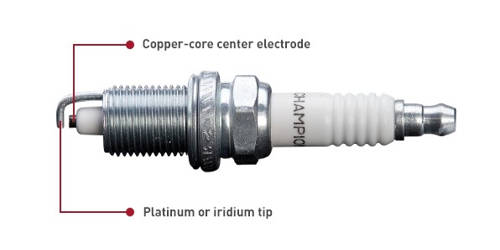A spark plug is a device for delivering electric current from an ignition system to the combustion chamber of a spark-ignition engine to ignite the compressed fuel/air mixture by an electric spark while containing combustion pressure within the engine. The plug is connected to the high voltage generated by an ignition coil or magneto. A spark plug has a metal threaded shell, electrically isolated from a central electrode by a porcelain insulator. As the electrons flow from the coil, a voltage difference develops between the center electrode and side electrode. The central electrode, which may contain a resistor, is connected by a heavily insulated wire to the output terminal of an ignition coil or magneto. The spark plug’s metal shell is screwed into the engine’s cylinder head and thus electrically grounded. Once the voltage exceeds the dielectric strength of the gases, the gases become ionized. The central electrode protrudes through the porcelain insulator into the combustion chamber, forming one or more spark gaps between the inner end of the central electrode and usually one or more protuberances or structures attached to the inner end of the threaded shell and designated the side, earth, or ground electrode(s). Spark-gap length affects the energy of the spark, and the shape of the insulator affects the temperature of operation.
Primary functions –
- To ignite the air/fuel mixture. Electrical energy is transmitted through the spark plug, jumping the gap in the plugs firing end if the voltage supplied to the plug is high enough.
- To remove heat from the combustion chamber. Spark plugs cannot create heat, they can only remove heat.
Spark plugs may also be used for other purposes; in Saab Direct Ignition when they are not firing, spark plugs are used to measure ionization in the cylinders – this ionic current measurement is used to replace the ordinary cam phase sensor, knock sensor and misfire measurement function. In terms of operation, the spark plug is connected to the high voltage generated by an ignition coil. The electrical energy (voltage) it transmits is extremely high in order to create a spark and to “light the fire” within the controlled chaos of the combustion chamber. Spark plugs may also be used in other applications such as furnaces wherein a combustible fuel/air mixture must be ignited. In this case, they are sometimes referred to as flame igniters. In terms of construction, spark plugs may not be quite as simple as you think. In fact, they are precision pieces of equipment.
















